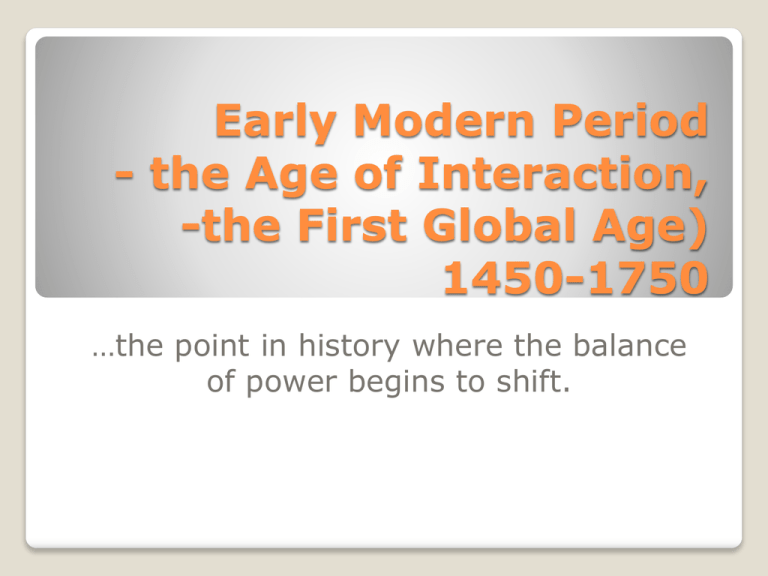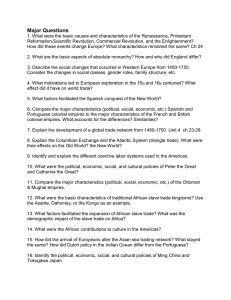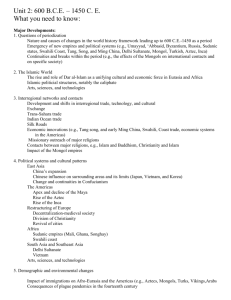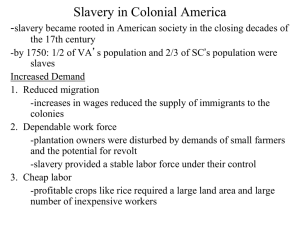Early Modern Period - the Age of Interaction, -the First Global Age) 1450-1750
advertisement

Early Modern Period - the Age of Interaction, -the First Global Age) 1450-1750 …the point in history where the balance of power begins to shift. Periodization…mostly in line Analyze the changes and continuities in Western Europe. Compare the paths of non-Western societies in Asia, Africa & the Americas. Characterize the world economy during this period. Analyze the impact of technology on this period. Questions to Consider Political organization—Empire Building Cultural & Intellectual Movements Interaction & its Consequences ◦ Trade ◦ Demographic Shifts Technology Gender Roles Themes to Consider (most themes tied heavily into the theme of interaction) Analyze the changes and continuities in Western Europe. Key Empires emerge at this time as a result of: ◦ Revolutions in thought and culture ◦ Exploration ◦ Commercial Revolution Similarities? Differences? Case Studies: Catholic vs. Protestant Nations, Absolute vs. Limited Monarchies Changes Continuities? Growth of cities Middle class Marriage and family structure Questioning spirit Women’s roles religion Changes and Continuities? Land based Empires: Compare responses to West Tokugawa Japan Aztec/Inca Don’t forget the outliers… Cultural and intellectual developments, Dates Famous People or Events Content of Idea or Movement Diffusion (Where did the ideas spread?) Scientific Revolution Copernicus Galileo Francis Bacon William Harvey World could be explained through natural laws rather than superstition Sun was the center of the universe Scientific Method Questions traditional church teachings Europe/American colonies Enlightenment John Locke Jean-Jacques Rousseau Thomas Hobbes Voltaire Natural Rights – life, liberty and property Right of people to revolt and overthrow government Freedom of speech, press, and religion Europe/American colonies Neoconfucianism Zhu Xi combine elements of Buddhism and Daoism to make Confucianism more accessible for less literate China, Korea, Japan Cultural and Intellectual Movements Chinese Exchanges in arts Italian Renaissance paintings Mughal minature paintings Taj Mahal celebration of beauty focus on individual achievement Europe and its colonies, South Asia Characterize the world economy during this period. The New World Economy/Trade Slave Systems: Coercive or Forced Labor slave trade (Trans Saharan and East Africa) Locations and Characteristics Forced Labor's Impact on Demographic Changes East Africa 15 to 25 million slaves transported to the Americas Treatment of Slaves Status of Slaves mostly woman part of kinship middle passage silver mining plantations maroons/work stoppages not much social mobility plantation slavery (Atlantic Slave System) Carribean North America South America Mamluks/Janissaries Abbasid(Mamluks) Ottoman Empire military service mobility serfs Eastern Europe Russia becomes "virtual slavery" some mobility Demographics: coercive labor Spread of epidemic disease ◦ Smallpox, measles, flu, STD’s Population decreases dramatically in Americas, leading to the decline of civilizations in Mesoamerica and the Andes. New racial hierarchies More Demography Degradation of New World The Little Ice Age Human Interactions w/Environment Cartography Compass Astrolabe Lateen sails New ship designs Analyze the impact of technology on this period. Compare the role of women in two premodern societies. Little change from previous period Impact of Interaction on Women Europe: nominal impact of Renaissance/Reformation Outside of Europe: ◦ Powerful Exceptions: Elizabeth I, Queen Isabella, Nur Jahan ◦ Still shared power (except Elizabeth) ◦ Racial miscegenation in Americas ◦ Changes in trade/production ◦ Africa matrilineal but impacted by slave trade ◦ Neoconfucianism in China Women



